The Common Vein Copyright 2011
Definition
Fractures of the fibula are usually caused by direct trauma, twisting, avulsion, or rotational forces and are often characterized by associated injuries with the tibia because of the interosseus membrane which forces the two bones to move as a unit.
Fibula fractures can be either open or closed injuries. The location of the fracture on the fibula varies.
Proximal fibula fractures or a Maisonneuve fracture can occur as a result of external rotation of the ankle. There is syndesmotic injury that leads to the fibula to fracture proximally. Duputren?s fracture is also a high fibular fracture from a similar mechanism to the Maisonneuve fracture.
Fibular shaft fractures often occur in conjunction with fractures of the tibial shaft. Fibular shaft fractures can occur in isolation however. These fractures can be open or closed. Fractures are described based on the pattern, location, and level of comminution. Spiral, transverse, and oblique fractures are simple. Wedge fractures include spiral wedge, bending wedge, and fragmented wedge. Complex fractures include spiral, segmented, and irregular.
Ankle fractures can contain a tibial and/or fibular component. The Lauge-Hansen Classification system describes the injuries that result from four different mechanisms; supination-adduction (SA), supination-external rotation (SER), pronation-abduction (PA), and pronation-external rotation (PER).
The fracture may be complicated in the acute phase by neurovascular injury, or in the subacute or chronic phases by nonunion, malunion, infection, osteonecrosis, or osteoarthritis. Complications that are specific to the fibula include loss of ankle motion, compartment syndrome, peroneal nerve injury, vascular injury, reflex sympathetic dystrophy, fat embolism, and claw toe deformity.
The diagnosis of this injury is usually made by a combination of physical examination and x-ray imaging.
Imaging includes the use of plain x-rays, and if indicated CT-scan, or MRI.
Proximal fibula fractures are typically treated non-operatively at the site of the fracture, but may require a surgery to repair the syndesmotic injury distally.
Isolated fibular shaft fractures are treated nonoperatively with weight bearing as tolerated. The fibular shaft fracture in a combination tibia/fibula fracture is treated by repairing the tibial shaft fracture. Tibial shaft fractures can be treated nonoperatively if there is minimal displacement. Tibial shaft fractures with displacement or comminution can be treated with intramedullary nailing, flexible nails, external fixation devices, or plates and screws. Intramedullary nailing is typically performed.
Ankle fractures are typically given an attempt at closed reduction to try to regain anatomic alignment. Often a reduction can reduce the need for surgery. Unstable fractures, open fractures, and failure to achieve anatomic alignment by closed reduction requires open reduction and internal fixation (ORIF) surgery.
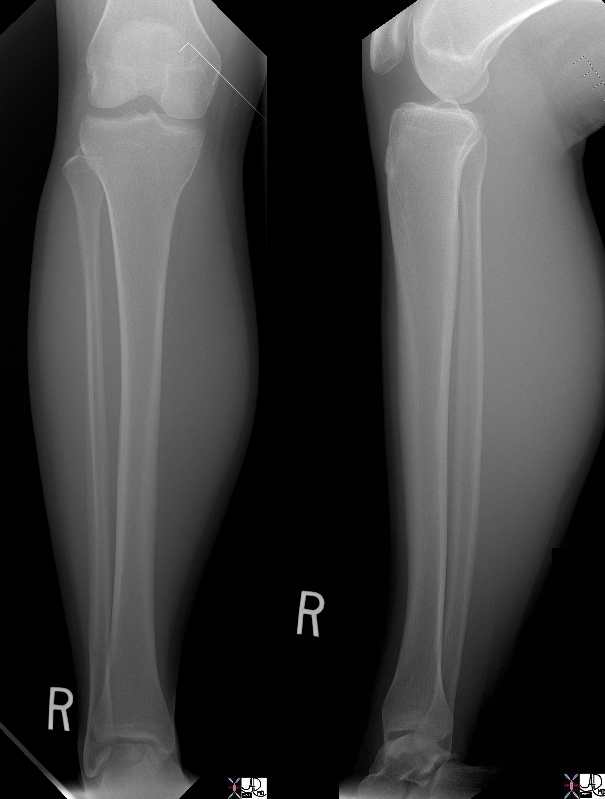
Ashley Davidoff MD
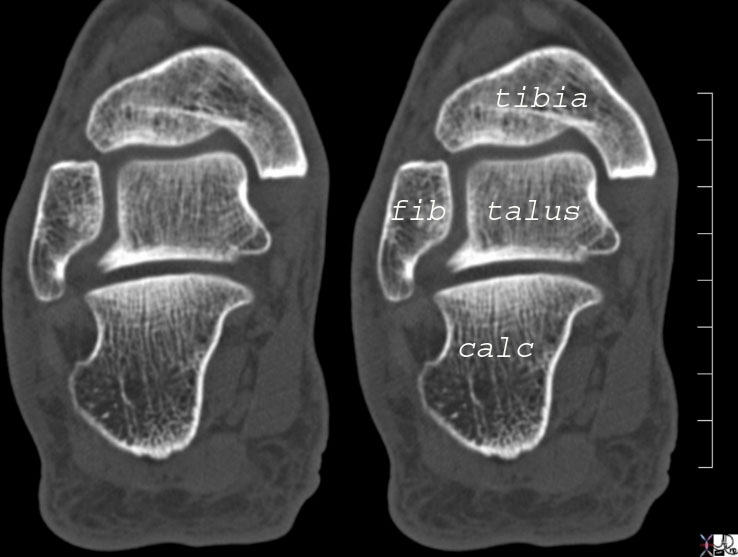
The axial section CT scan of the forefoot exemplifies the normal anatomy of the distal tibia, fibula, tibio-talar joint.
The talus is central to the stability of the joint
Courtesy Ashley Davidoff MD 72583c01
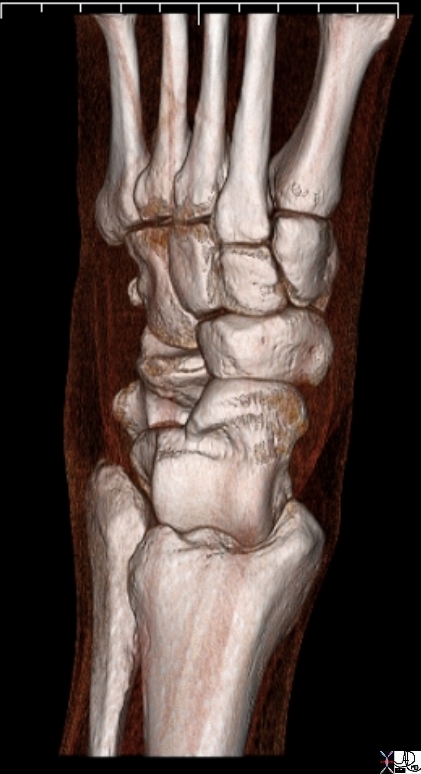
The 3D reconstructed CT scan of the forefoot exemplifies the normal anatomy of the distal tibia, fibula, tibio-talar joint, talo navicular joint, and navicular cuboid. The cuneiforms are also well visualized. This patient does have an avulsion fracture off the navicular but it is not obvious on this view.
Courtesy Ashley Davidoff MD 72585
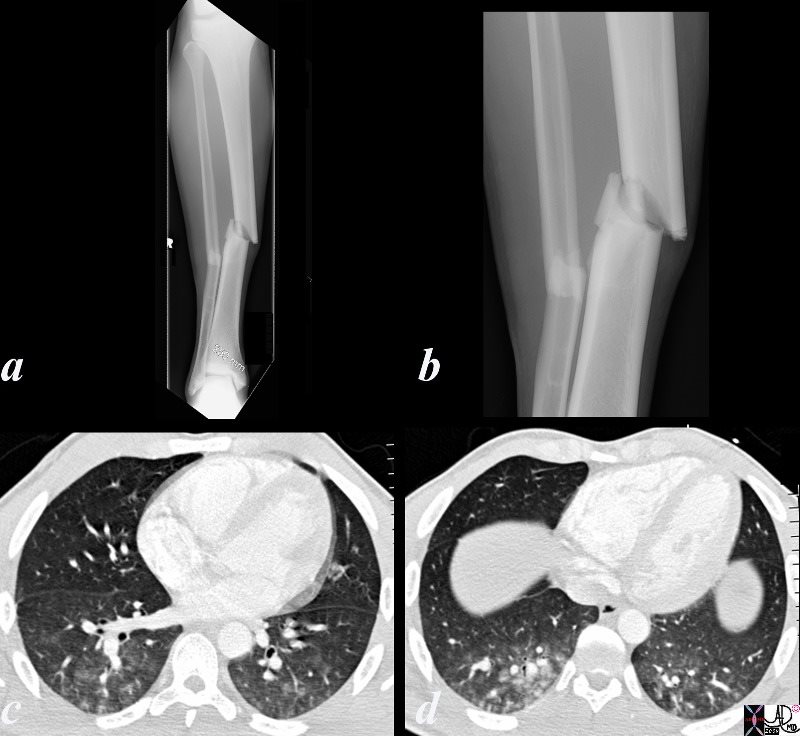
The images are from a 21 year old college student and football player who sustained a transverse fractures of his right tibia and fibula. While awaiting surgery he became short of breath, tachypneic and tachycardic with his saturations dropping to the 70’s from 90’s on room air. He had a fever to 103, heart rate of 100, with a respiratory rate of 30 and a systolic pressure of 140. He required intubation for 5 days The plain films show fractures through the mid shaft which is the region of the medullary canal and where fat containing yellow resides in medullary cavity. The CTscan in c and d show ill defined fluffy nodules with ground glass changes and thickening of the interlobular septa at the lung bases. Centrilobular nodularity is suggested. The clinical presentation together with the location of the fractures and CT appearance suggest a diagnosis of fat embolism.
Courtesy Ashley Davidoff MD copyright 2009 all rights reserved 86255c.8s
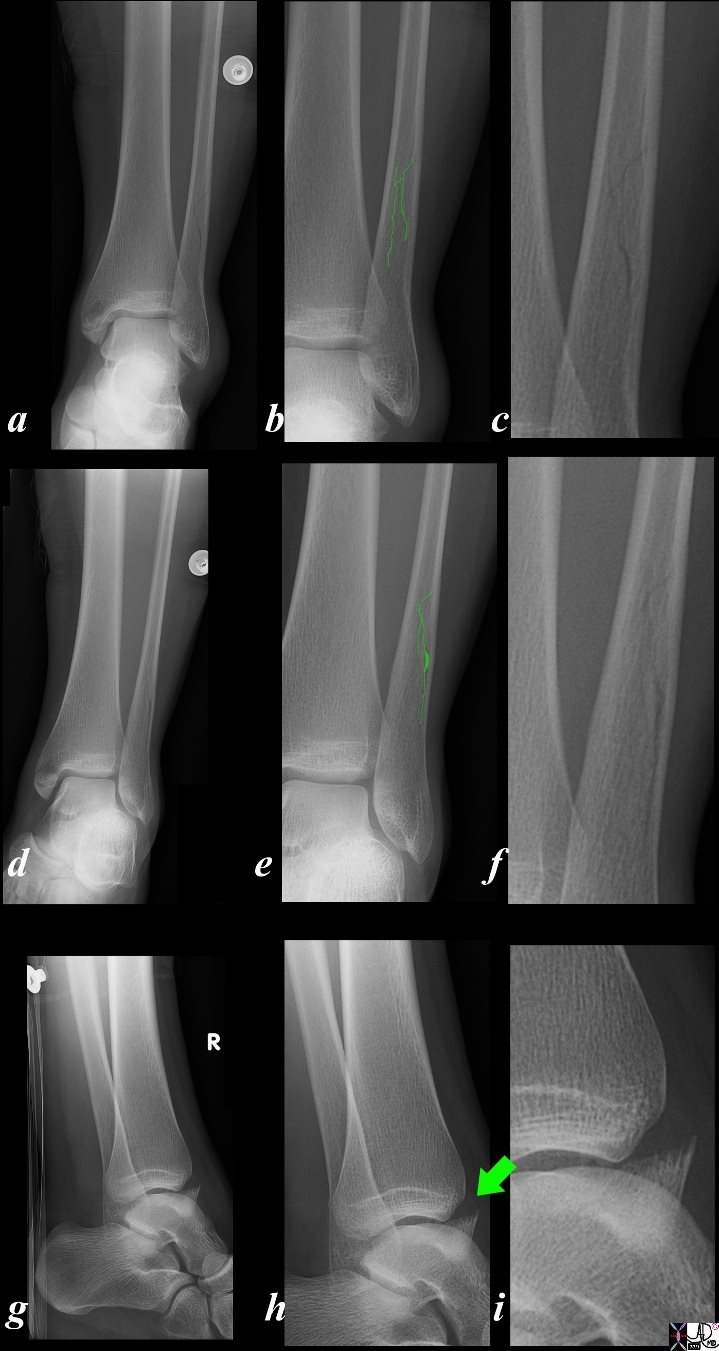
The X-ray of the ankle in a 15 year old male in the anteroposterior projection (A-P) shows a simple incomplete complex hairline fracture of the distal fibula (b, e green overlay) magnified in c and f, and an avulsion fracture of the anterior portion of the distal tibia (green arrow h). The close relationship of the two bones in the ankle region and the presence of an interosseus membrane that binds the two bones into a single unit, makes combination fractures common. .
Courtesy Ashley Davidoff Copyright 2011 99940c03.8s
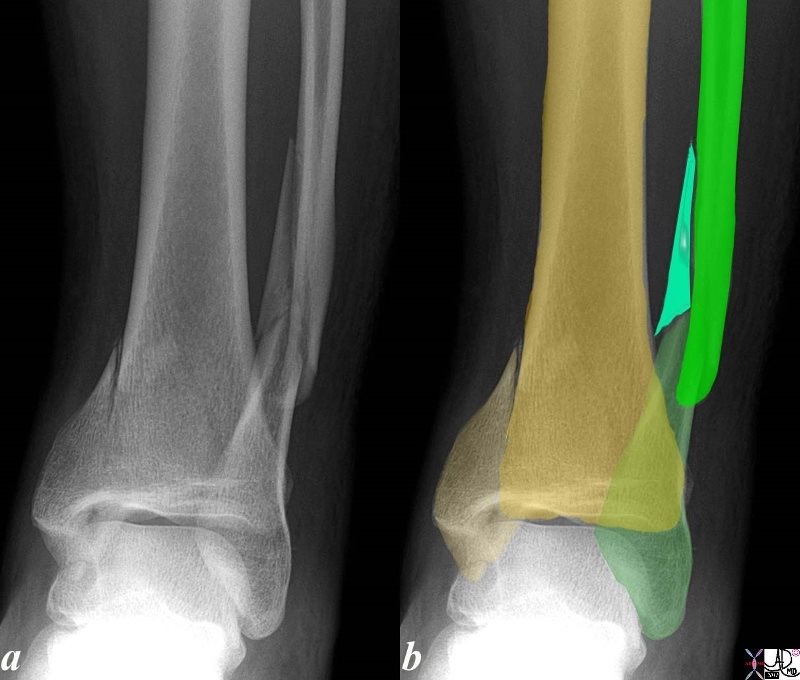
The X-ray of the right ankle in the anteroposterior projection (A-P) shows a simple appearing vertical fracture of the tibia with near anatomical alignment and a comminuted spiral fracture of the distal shaft of the fibula with a butterfly fragment (overlaid in turquoise in b) The close relationship of the two bones in the ankle region an the presence of an interosseus membrane that binds the two bones into a single unit makes combination fractures common. .
Courtesy Ashley Davidoff Copyright 2011 101075b04L.8
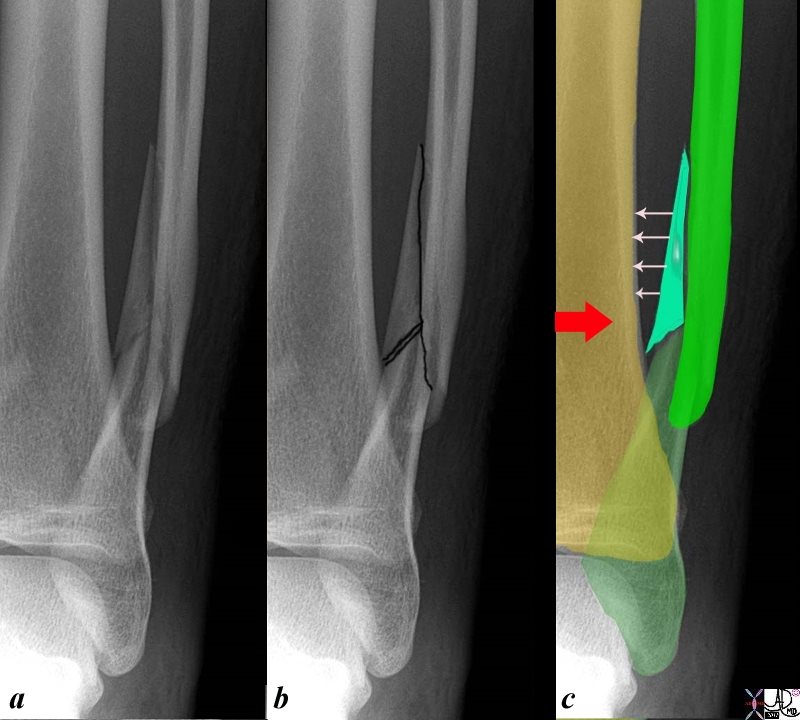
This X-ray on the antero-posterior (A-P) projection shows a comminuted spiral fracture of the distal shaft of the fibula in a 26 year old male. Image b shows the fracture as best depicted in a single projection with black overlay, while image c reveals three fragments with the lightest turquoise green overlaying the triangular or butterfly fragment. The mechanism of this injury is usually a twisting or torsional injury. The interosseous membrane also acts as a resisting force and may account for the butterfly fragment
Courtesy Ashley Davidoff Copyright 2011 101075b06L.81c
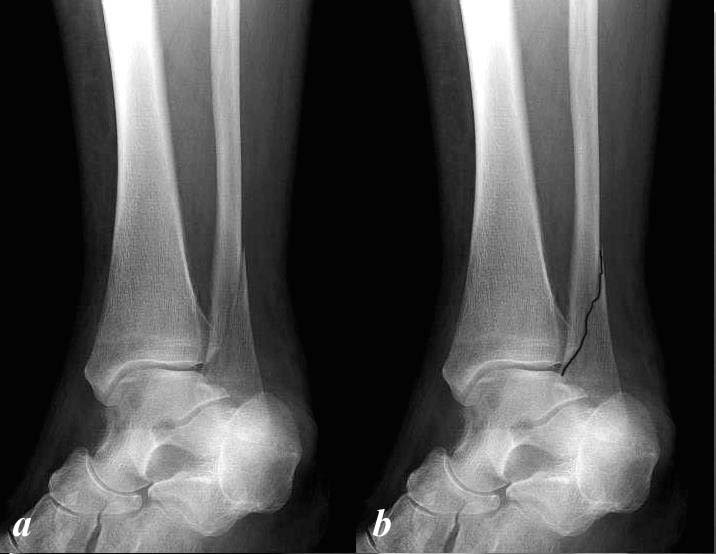
Courtesy Ashley Davidoff Copyright 2011 99936.8cL
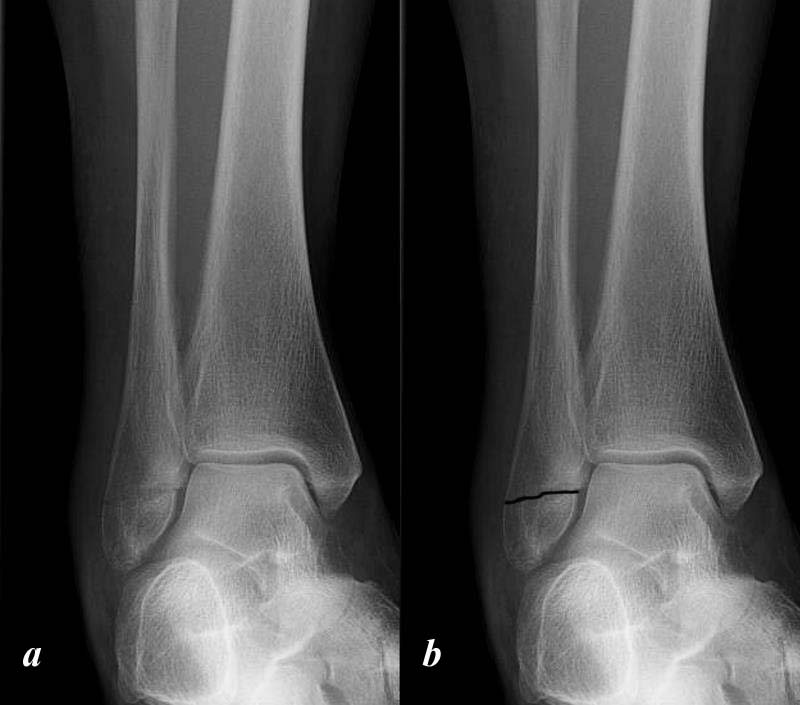
This X-ray on the antero-posterior (A-P) projection shows a simple transverse fracture of the distal fibula in a 26 year old male. Image b shows the fracture with black overlay. The fracture reveals maintenance of anatomical alignment with bone to bone contact.
Courtesy Ashley Davidoff Copyright 2011 101128.8cL
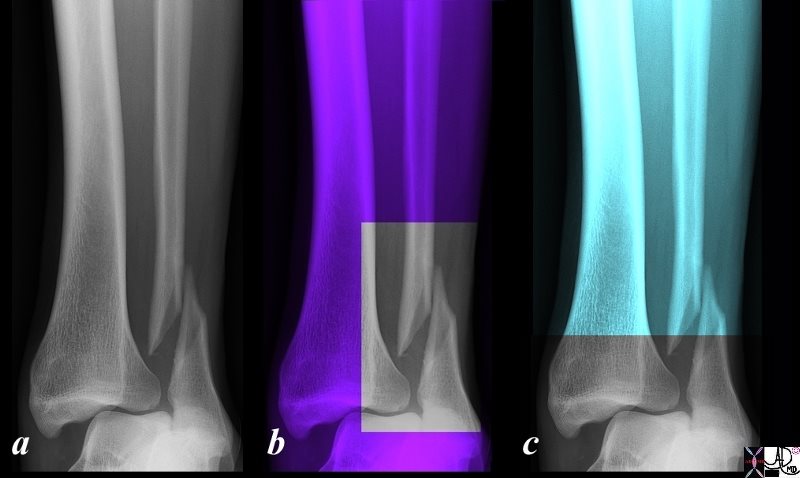
This X-ray on the antero-posterior (A-P) projection shows a simple displaced oblique fracture of the distal shaft of the fibula in a 36 year old male following blunt trauma. In image b the ankle is overlaid in purple and the area of interest is highlighted in black and white. There is significant, lateral displacement of the distal fragment so there is virtually no bone on bone alignment. This morphology is not conducive to satisfactory healing and likely would require open reduction. In addition to the fracture there has been significant damage to soft tissues and the mortise is not intact with medial displacement and subluxation of the tibia in relation to the talus suggesting rupture of at least the deltoid ligament. In image c the ankle is overlaid in teal blue and the subluxed tibia is highlighted in black and white. The mechanism of this injury is likely due to a an inversion injury of the ankle resulting in an oblique fracture of the fibula and subluxation of the tibia off the talus.
Courtesy Ashley Davidoff Copyright 2011 99854.6b01c01.8s
References
Davis MF, Davis PF, Ross DS. Expert Guide to Sports Medicine. ACP Series, 2005.
Elstrom J, Virkus W, Pankovich (eds), Handbook of Fractures (3rd edition), McGraw Hill, New York, NY, 2006.
Koval K, Zuckerman J (eds), Handbook of Fractures (3rd edition), Lippincott Williams & Wilkins, Philadelphia, PA, 2006.
Lieberman J (ed), AAOS Comprehensive Orthopaedic Review, American Academy of Orthopaedic Surgeons, 2008.
Moore K, Dalley A (eds), Clinically Oriented Anatomy (5th edition), Lippincott Williams & Wilkins, Philadelphia, PA, 2006.
Wheeless?s Textbook of Orthopaedics: Maissonneuve Fracture (http://www.wheelessonline.com/ortho/maisonneuve_fracture)
